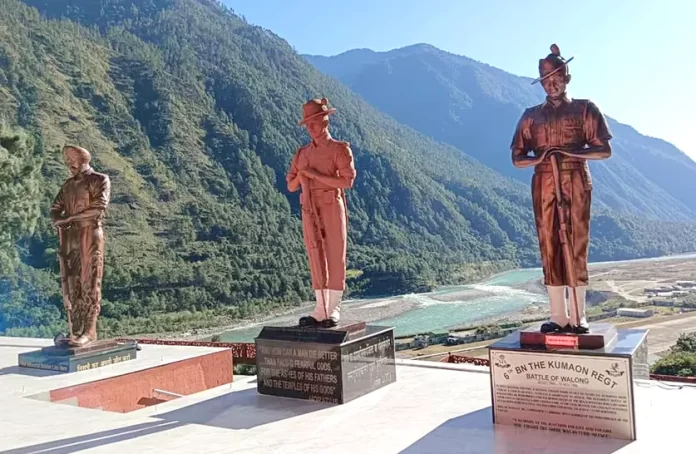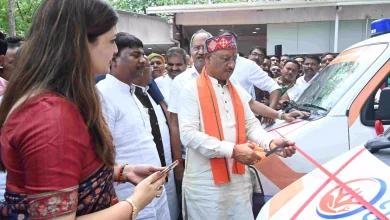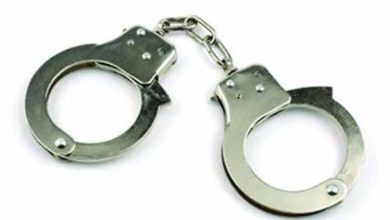Pride and Courage: The Walong Legacy

Nestled in the serene and picturesque Anjaw district of Arunachal Pradesh, the Walong War Memorial stands as a powerful testament to the bravery and sacrifices of Indian soldiers during the 1962 Sino-Indian war. This monumental site not only commemorates the gallant defence of our borders but also instils a deep sense of respect and admiration for the soldiers’ sacrifices among generations who visit this hallowed ground.
A symbol of sacrifice and strength
The Walong War Memorial pays homage to the indomitable spirit of Indian soldiers who fought valiantly during the Battle of Walong in October-November 1962. Despite being outnumbered and facing harsh terrain, Indian troops displayed unparalleled courage in resisting the advancing Chinese forces. Their brave stand delayed the enemy and showcased India’s resolve to protect its sovereignty, even under the most challenging circumstances.
Under the visionary leadership of Lt General KT Parnaik, the honourable governor of Arunachal Pradesh, the memorial was inaugurated on 14 November, 2024 to honour these sacrifices. This initiative ensures that the site remains a fitting tribute to the soldiers’ valour and a source of inspiration for visitors.
Walong’s strategic importance
Walong holds immense strategic importance for India and its neighbour China. Located near the trijunction of India, China and Myanmar, it serves as a critical outpost in safeguarding India’s eastern borders. For India, Walong’s rugged terrain and geographical vantage points play a key role in monitoring the line of actual control (LAC) and ensuring border security.
China, on the other hand, has made rapid advancements across the border. The construction of highly modernised railway stations, airports, and military bases, coupled with a robust communication network, highlights Beijing’s strategic preparedness. In contrast, India’s side remains underdeveloped, with poor infrastructure and limited communication facilities. Strengthening infrastructure in this region is crucial for matching China’s pace and ensuring India’s strategic and operational readiness.
Kaho: India’s first village
Located just a few kilometres from the border, Kaho is the first village of India. This quaint settlement, surrounded by breathtaking mountains and dense forests, is home to a small community of resilient and patriotic individuals. Despite its strategic location, Kaho faces significant challenges due to its remoteness and lack of modern infrastructure.
The Indian Army and local residents face harsh conditions here, battling extreme weather, difficult terrain, and the constant pressure of maintaining vigilance along the border. The lack of proper roads, healthcare facilities, and consistent power supply adds to their struggles. This makes the need for improved infrastructure and enhanced connectivity even more urgent.
The warm hospitality of the locals
Walong and its surrounding villages are home to the Mishmi and Meyor tribes, known for their warm hospitality and vibrant cultures. Visitors are often greeted with a friendly smile and treated to the region’s traditional sweets and delicacies, which reflect the simplicity and richness of the local way of life.
The locals’ connection to nature is evident in their customs, food, and sustainable way of living. Their warmth and generosity make every visitor feel at home, leaving an indelible mark on their journey.
Kibitho: The jewel of the eastern Himalayas
Not far from Walong lies Kibitho, another vital location known for its stunning natural beauty and strategic significance. This village features the mural of the late general Bipin Rawat, the former chief of defence staff (CDS), and the Bipin Rawat Dwar, a memorial gate named in his honour.
The village offers awe-inspiring views of snow-capped peaks, lush forests, cascading waterfalls, and the mighty Lohit river, making it a haven for nature lovers. It is also a poignant reminder of the sacrifices made by the armed forces, as visitors can see Chinese military installations across the border.
Spiritual serenity at gonpas
The region is dotted with beautiful gonpas (Buddhist monasteries), which add a spiritual dimension to the natural and historical significance of Walong. These serene monasteries, often perched atop hills, offer breathtaking views of the surrounding landscape and provide a space for quiet reflection. The gonpas are also a testament to the harmonious coexistence of spirituality and nature in this region.
Natural and cultural treasures
The region’s natural bounty includes pristine grasslands, pines, rivers, and hot water springs, making it an ecological paradise. Dong, the first place to witness the sunrise in the country, is surrounded by tranquil beauty and steaming hot springs.
Adding to the charm are the organic kiwis, apples, and medicinal herbs (jari buti) that thrive in the region’s untouched environment. These products offer a glimpse into the sustainable way of life practiced by the locals. The traditional Mishmi culture, cuisine, and warm hospitality further enhance the experience for visitors.
Challenges faced by locals and military
The remote location and lack of infrastructure pose significant challenges for the local population and the armed forces stationed here. The absence of modern amenities, coupled with harsh winters and unpredictable weather, makes everyday life a struggle. For the military, the tough terrain and limited logistical support make border patrolling and defence operations arduous.
Meanwhile, on the Chinese side, state-of-the-art infrastructure, including high-speed railways and airbases, provides their troops with better mobility and operational efficiency. This stark contrast underscores the urgent need for India to prioritise infrastructure development, communication networks, and logistics in the Walong-Kibitho-Kaho region.
Why everyone should visit Walong
Walong, Kibitho, and Kaho are more than just destinations; they are embodiments of India’s history, natural beauty, and resilience. Visitors from across India and the world should explore these places to pay homage to the soldiers who sacrificed their lives, appreciate the unparalleled beauty of Arunachal, and witness the region’s strategic importance firsthand.
The tourist lodges and local homestays ensure that visitors can enjoy their stay comfortably while experiencing the local culture and hospitality. Improved tourism can also bring much-needed development and awareness to the region.
A call for development and pride
A visit to these villages is not just a journey; it is an awakening. The Walong War Memorial, rejuvenated under Governor Parnaik’s leadership, the Bipin Rawat Dwar, the peaceful gonpas, and the picturesque surroundings remind us of the sacrifices that safeguard our freedom. But they also highlight the urgent need for development to support the people and soldiers who embody the spirit of this land.







